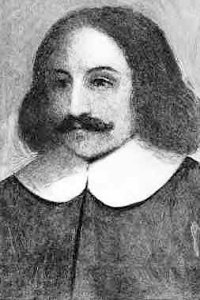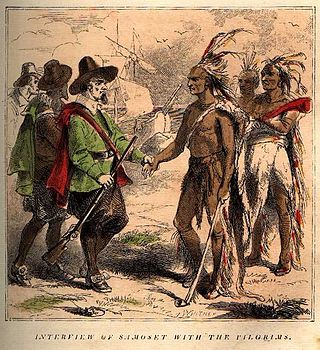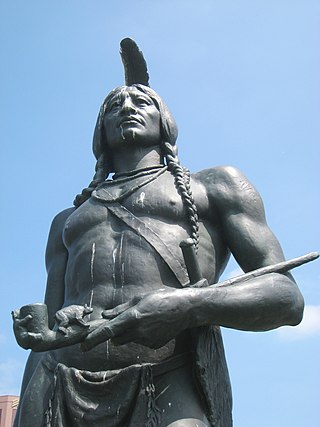Related Research Articles

The Pilgrims, also known as the Pilgrim Fathers, were the English settlers who traveled to America on the Mayflower and established the Plymouth Colony in Plymouth, Massachusetts. The Pilgrims' leadership came from the religious congregations of Brownists, or Separatist Puritans, who had fled religious persecution in England for the tolerance of 17th-century Holland in the Netherlands.

Myles Standish was an English military officer and colonist. He was hired as military adviser for Plymouth Colony in present-day Massachusetts, United States by the Pilgrims. Standish accompanied the Pilgrims on the ship Mayflower and played a leading role in the administration and defense of Plymouth Colony from its foundation in 1620. On February 17, 1621, the Plymouth Colony militia elected him as its first commander and continued to re-elect him to that position for the remainder of his life. Standish served at various times as an agent of Plymouth Colony on a return trip to England, as assistant governor of the colony, and as its treasurer.

Plymouth Colony was the first permanent English colony in New England from 1620 to 1691 and the second permanent English colony in America, after the Jamestown Colony. It was settled by the passengers on the Mayflower at a location that had previously been surveyed and named by Captain John Smith. The settlement served as the capital of the colony and developed as the town of Plymouth, Massachusetts. At its height, Plymouth Colony occupied most of the southeastern portion of Massachusetts. Many of the people and events surrounding Plymouth Colony have become part of American folklore, including the American tradition of Thanksgiving and the monument of Plymouth Rock.

William Bradford was an English Puritan Separatist originally from the West Riding of Yorkshire in Northern England. He moved to Leiden in Holland in order to escape persecution from King James I of England, and then emigrated to the Plymouth Colony on the Mayflower in 1620. He was a signatory to the Mayflower Compact and went on to serve as Governor of the Plymouth Colony intermittently for about 30 years between 1621 and 1657. He served as a commissioner of the United Colonies of New England on multiple occasions and served twice as president. His journal Of Plymouth Plantation covered the years from 1620 to 1646 in Plymouth.

Tisquantum, more commonly known as Squanto, was a member of the Patuxet tribe best known for being an early liaison between the Native American population in Southern New England and the Mayflower Pilgrims who made their settlement at the site of Tisquantum's former summer village. The Patuxet tribe had lived on the western coast of Cape Cod Bay, but they were wiped out by an epidemic infection, likely brought by previous European explorers.

Samoset was an Abenaki sagamore and the first American Indian to make contact with the Pilgrims of Plymouth Colony in New England. He startled the colonists on March 16, 1621 by walking into Plymouth Colony and greeting them in English, saying "Welcome, Englishmen."

The National Day of Mourning is an annual demonstration, held on the fourth Thursday in November, that aims to educate the public about Native Americans in the United States, notably the Wampanoag and other tribes of the Eastern United States; dispel myths surrounding the Thanksgiving story in the United States; and raise awareness toward historical and ongoing struggles facing Native American tribes. The first National Day of Mourning demonstration was held in 1970 after Frank "Wamsutta" James's speaking invitation was rescinded from a Massachusetts Thanksgiving Day celebration commemorating the 350th anniversary of the landing of the Mayflower. James instead delivered his speech on Cole's Hill in Plymouth, Massachusetts next to a statue of Ousamequin, where he described Native American perspectives on the Thanksgiving celebrations. The gathering became an annual event organized by the United American Indians of New England (UAINE) and coincides with both Thanksgiving Day in the United States and with Unthanksgiving Day, an annual ceremony held on Alcatraz Island in California.

John Carver was one of the Pilgrims who braved the Mayflower voyage in 1620 which resulted in the creation of Plymouth Colony in America. He is credited with writing the Mayflower Compact and was its first signer, and he was also the first governor of Plymouth Colony.

Massasoit Sachem or Ousamequin was the sachem or leader of the Wampanoag confederacy. Massasoit means Great Sachem. Massasoit was not his name but a title. English colonists mistook Massasoit as his name and it stuck.

The Pokanoket was the village governed by Massasoit. The term broadened to refer to all peoples and lands governed by Massasoit and his successors, which were part of the Wampanoag people in what is now Rhode Island and Massachusetts.

Edward Winslow was a Separatist and New England political leader who traveled on the Mayflower in 1620. He was one of several senior leaders on the ship and also later at Plymouth Colony. Both Edward Winslow and his brother, Gilbert Winslow signed the Mayflower Compact. In Plymouth he served in a number of governmental positions such as assistant governor, three times was governor and also was the colony's agent in London. In early 1621 he had been one of several key leaders on whom Governor Bradford depended after the death of John Carver. He was the author of several important pamphlets, including Good Newes from New England and co-wrote with William Bradford the historic Mourt's Relation, which ends with an account of the First Thanksgiving and the abundance of the New World. In 1655 he died of fever while on an English naval expedition in the Caribbean against the Spanish.

Plimoth Patuxet is a complex of living history museums in Plymouth, Massachusetts founded in 1947, formerly Plimoth Plantation. It replicates the original settlement of the Plymouth Colony established in the 17th century by the English colonists who became known as the Pilgrims, as well as that of the Patuxet people upon whose land the Pilgrims settled. They were among the first people who emigrated to America to seek religious separation from the Church of England. It is a not-for-profit museum supported by administrations, contributions, grants, and volunteers. The recreations are based upon a wide variety of first-hand and second-hand records, accounts, articles, and period paintings and artifacts, and the museum conducts ongoing research and scholarship, including historical archaeological excavation and curation locally and abroad.
Speedwell was a 60-ton pinnace that carried the Pilgrims from Leiden, Holland to England, where they intended to sail to America aboard both Speedwell and the Mayflower in 1620. The Pilgrims initially set sail in both ships, but Speedwell was found to be unseaworthy and both ships returned to Plymouth. The Pilgrims later left Speedwell behind and sailed in the Mayflower.

Isaac Allerton, and his family, were passengers in 1620 on the historic voyage of the ship Mayflower. Allerton was a signatory to the Mayflower Compact. In Plymouth Colony he was active in colony governmental affairs and business and later in trans-Atlantic trading. Problems with the latter regarding colony expenditures caused him to be censured by the colony government and ousted from the colony. He later became a well-to-do businessman elsewhere and in his later years resided in Connecticut.

Iyannough was an American Indian sachem and leader of the Mattachiest tribe of Cummaquid in the area of what is now Barnstable, Massachusetts. The village of Hyannis, the Wianno section of Osterville, and Iyanough Road are all named after him.

Abenaki, also known as Wôbanakiak, is an endangered Eastern Algonquian language of Quebec and the northern states of New England. The language has Eastern and Western forms which differ in vocabulary and phonology and are sometimes considered distinct languages.

Mayflower was an English ship that transported a group of English families, known today as the Pilgrims, from England to the New World in 1620. After a grueling 10 weeks at sea, Mayflower, with 102 passengers and a crew of about 30, reached what is today the United States, dropping anchor near the tip of Cape Cod, Massachusetts, on November 21 [O.S. November 11], 1620.

The Patuxet were a Native American band of the Wampanoag tribal confederation. They lived primarily in and around modern-day Plymouth, Massachusetts, and were among the first Native Americans encountered by European settlers in the region in the early 17th century. Most of the population subsequently died of epidemic infectious diseases. The last of the Patuxet – an individual named Tisquantum, who played an important role in the survival of the Pilgrim colony at Plymouth – died in 1622.
In the fall of 1621 the Fortune was the second English ship destined for Plymouth Colony in the New World, one year after the voyage of the Pilgrim ship Mayflower. Financed as the Mayflower was by Thomas Weston and others of the London-based Merchant Adventurers, Fortune was to transport thirty-five settlers to the colony on a ship that was much smaller than Mayflower. The Fortune required two months to prepare for the voyage and once underway, reached Cape Cod on 9 November 1621 and the colony itself in late November. The ship was unexpected by those in the Plymouth colony and although it brought useful settlers, many of whom were young men, it brought no supplies, further straining the limited food resources of the colony. The ship only stayed in the colony for about three weeks, returning to England in December loaded with valuable furs and other goods. But when nearing England, instead of heading to the English Channel, a navigation error caused the ship to sail southeast to the coast of France, where it was overtaken and seized by a French warship.
Mayflower: A Story of Courage, Community, and War is a 2006 American history book by American author Nathaniel Philbrick, published by Viking Press. The book tells the events of the Mayflower colonists' landing in North America, and their relations over the following decades with the indigenous Wampanoag people, culminating in the bloody King Philip's War of 1675–78.
References
- ↑ "NATIONAL GEOGRAPHIC CHANNEL ANNOUNCES CAST OF FOUR-HOUR MOVIE EVENT SAINTS & STRANGERS". Zap2It. July 6, 2015. Archived from the original on July 7, 2015. Retrieved August 23, 2015.
- ↑ "'Saints & Strangers' Cast on Bringing Early American Settlers to Life". Variety. October 29, 2015. Retrieved October 29, 2015.
- ↑ Landry, Alysa (November 25, 2015). "How 'Saints & Strangers' Got It Wrong: A Wampanoag Primer". Indian Country Today Media Network.com. Retrieved 21 April 2016.
- 1 2 Ryan, Maureen (November 19, 2015). "TV Review: 'Saints & Strangers'". Variety . Retrieved 21 April 2016.
- ↑ "Productions Hosted" (PDF). Cape Town Film Studios. 2018. Archived (PDF) from the original on 8 January 2021. Retrieved 8 January 2021.
- ↑ "Saints & Strangers". Rotten Tomatoes .
- ↑ "Saints & Strangers". Metacritic .
- ↑ "'Saints & Strangers': TV Review". The Hollywood Reporter . 18 November 2015.
- ↑ "How 'Saints & Strangers' Got It Wrong: A Wampanoag Primer - Indian Country Media Network". Indian County Media Network. 2 February 2017. Archived from the original on 2017-02-02.